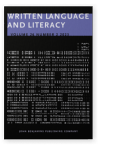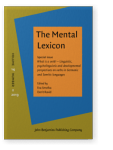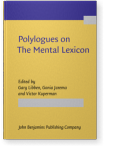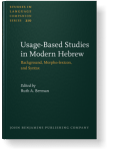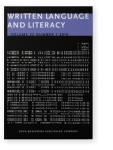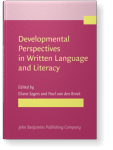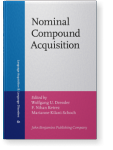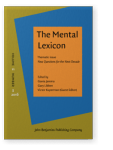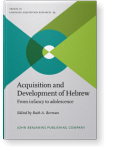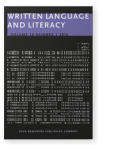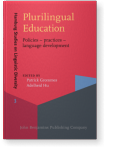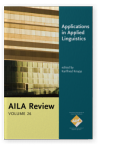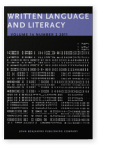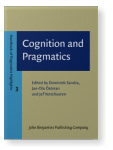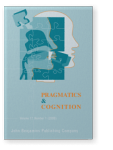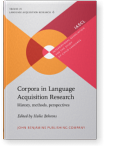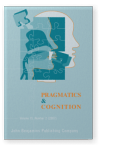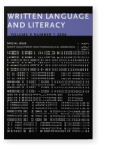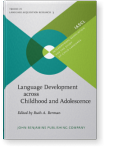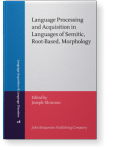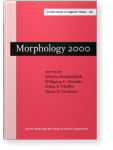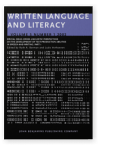Dorit Ravid
List of John Benjamins publications for which Dorit Ravid plays a role.
Journal
Title
What is a verb? – Linguistic, psycholinguistic and developmental perspectives on verbs in Germanic and Semitic languages
Edited by Eva Smolka and Dorit Ravid
Special issue of The Mental Lexicon 14:2 (2019) v, 164 pp.
Subjects Computational & corpus linguistics | Multilingualism | Neurolinguistics | Psycholinguistics | Semantics
2021 Chapter 5. Hebrew adjective lexicons in developmental perspective: Subjective register and morphology Polylogues on The Mental Lexicon: An exploration of fundamental issues and directions, Libben, Gary, Gonia Jarema and Victor Kuperman (eds.), pp. 109–142 | Chapter
2020 Chapter 8. Derivation Usage-Based Studies in Modern Hebrew: Background, Morpho-lexicon, and Syntax, Berman, Ruth A. (ed.), pp. 203–264 | Chapter
The chapter reviews derivational morphology in MH, as a domain critical to
lexical organization and content, with analyses based largely on empirical psycholinguistic
studies and distributional frequencies. Interrelations between derivation and inflection are
considered, with derivational processes… read more
2019 The development of adverbial clause functions in Hebrew narrative and expository writing across adolescence Written Language & Literacy 22:1, pp. 131–159 | Article
Interclausal subordination, serving various functions in written discourse, has been studied mostly from a quantitative perspective in later language development. The current study applied a discourse-functional approach to a quantitative and qualitative examination of subordinate Adverbial… read more
2019 Complexity and density of Hebrew verbs in preschool peer talk: The effect of socio-economic background What is a verb? – Linguistic, psycholinguistic and developmental perspectives on verbs in Germanic and Semitic languages, Smolka, Eva and Dorit Ravid (eds.), pp. 237–273 | Article
Hebrew verbs were analyzed in the peer talk produced by 36 Hebrew-speaking children in two age/schooling groups (4;0–5;0 and 5;0–6;0 years), and from two socio-economic backgrounds (SES), mid-high and low. Each of the four age/SES groups consisted of nine children in three triads, where each… read more
2019 What is a verb? Linguistic, psycholinguistic and developmental perspectives on verbs in Germanic and Semitic languages What is a verb? – Linguistic, psycholinguistic and developmental perspectives on verbs in Germanic and Semitic languages, Smolka, Eva and Dorit Ravid (eds.), pp. 169–188 | Introduction
Verbs constitute one of the basic building blocks of a clause, setting the structure of arguments and expressing the relationships among nouns in various thematic roles. In general terms, verbs are lexical items expressing verb-oriented notions such as activities, processes, and states. In… read more
2017 Chapter 3. Maternal input at 1;6: A comparison of two mothers from different SES backgrounds Social Environment and Cognition in Language Development: Studies in honor of Ayhan Aksu-Koç, Ketrez, F. Nihan, Aylin C. Küntay, Şeyda Özçalışkan and Aslı Özyürek (eds.), pp. 35–52 | Chapter
A body of research points to disadvantaged language and literacy skills in children from poorer, less educated backgrounds compared with those raised in more favorable circumstances. The current chapter reports a double case study comparing the child-directed speech of two Hebrew-speaking mothers… read more
2017 The development of Hebrew conjunct constructions in narration Developmental Perspectives in Written Language and Literacy: In honor of Ludo Verhoeven, Segers, Eliane and Paul van den Broek (eds.), pp. 119–135 | Chapter
The current chapter describes a psycholinguistic study of the development of conjunct constructions, a multi-functional coordinated syntactic structure that lies at the heart of complex Hebrew syntax, which can express variegated content in syntactically complex structures. Conjunct constructions… read more
2017 Chapter 11. Compounding in early child speech: Hebrew peer talk 2–8 Nominal Compound Acquisition, Dressler, Wolfgang U., F. Nihan Ketrez and Marianne Kilani-Schoch (eds.), pp. 251–274 | Chapter
This chapter traces the emergence and consolidation of Hebrew compounds across the childhood years, treating compounds as constructions (Goldberg 2003). Hebrew compounds are strictly nominal, with three different structures, each relating lexicon, morphology, and syntax: The bound smixut, the free… read more
2016 Hebrew adjective lexicons in developmental perspective: Subjective register and morphology New Questions for the Next Decade, Jarema, Gonia, Gary Libben and Victor Kuperman (eds.), pp. 401–428 | Article
Objective frequency does not always provide reliable information about lexical distributions across individuals’ development. We propose the subjective ranking by experts of lexical items’ register in the sense of ‘levels of linguistic usage’, which has been independently linked to AoA, as an… read more
2016 Foundations of the early root category: Analyses of linguistic input to Hebrewspeaking children Acquisition and Development of Hebrew: From infancy to adolescence, Berman, Ruth A. (ed.), pp. 95–134 | Article
The Semitic root is commonly assumed to be the main lexical prime in Hebrew, relating morphological families in the major word classes. Psycholinguistic evidence supports the role of the consonantal root in acquisition and processing of Hebrew, from children’s early ability to extract roots from… read more
2015 Spoken and written narration in Hebrew: A case study Written Language & Literacy 18:1, pp. 56–81 | Article
The study is premised on speech and writing relying on differently coordinated temporal frames of communication, aiming to pinpoint the conceptual and linguistic differences between spoken and written Hebrew narration. This is a case study presenting in-depth psycholinguistic analyses of the oral… read more
2014 L1 and L2 proficiency in Hebrew English adolescent learners Plurilingual Education: Policies – practices – language development, Grommes, Patrick and Adelheid Hu (eds.), pp. 219–244 | Article
The chapter examines knowledge of Hebrew and English vocabulary and constructions in native Hebrew-speaking students defined as “poor readers” in English as L2. Participants were two groups of 7th graders – 14 good readers and 11 poor readers respectively, and two groups of 9th graders – 14 good… read more
2014 Development of adjective frequencies across semantic classes: A growth curve analysis of child speech and child-directed speech Language, Interaction and Acquisition 5:2, pp. 185–226 | Article
This paper is a longitudinal investigation of adjective use by children aged 1;8−2;8, speaking Dutch, German, French, Hebrew, and Turkish, and by their caregivers. Each adjective token in transcripts of spontaneous speech was coded for semantic class. The development of adjective use in each… read more
2013 Linguistics in the service of communication disorders: New frontiers Applications in Applied Linguistics: AILA Review, Volume 26, Knapp, Karlfried (ed.), pp. 79–99 | Article
Linguistics and Communication Disorders are considered two different disciplines by most students and scholars in both fields as well as by researchers working in other relevant fields such as psychology and education. However, most core disorders, disabilities and delays in communicative ability… read more
2011 Linguistic diagnostics of written texts in two school-age populations Written Language & Literacy 14:2, pp. 161–187 | Article
The paper considers the writing abilities of Hebrew-speaking grade school and middle school students from mid-high compared with low SES backgrounds, as reflected in stories and compositions they wrote on the topic of friendship. A range of linguistic means of expression were employed as… read more
2009 Language acquisition Cognition and Pragmatics, Sandra, Dominiek, Jan-Ola Östman and Jef Verschueren (eds.), pp. 201–249 | Article
2009 Developing linguistic register across text types: The case of modern Hebrew Pragmatics & Cognition 17:1, pp. 108–145 | Article
The study considers the topic of linguistic register by examining how schoolchildren, adolescents, and adults vary the texts that they construct across the dimensions of modality (spoken/written discourse) and genre (narrative/expository discourse). Although register variation is presumably… read more
2008 Core morphology in child directed speech: Crosslinguistic corpus analyses of noun plurals Corpora in Language Acquisition Research: History, methods, perspectives, Behrens, Heike (ed.), pp. 25–60 | Article
2007 12. Acquiring diminutive structures and meanings in Hebrew: An experimental study The Acquisition of Diminutives: A cross-linguistic perspective, Savickienė, Ineta and Wolfgang U. Dressler (eds.), pp. 295–317 | Chapter
The chapter describes an experimental study of the acquisition of derivational diminutives in Hebrew. The study population consisted of 48 children in four age groups: 5–6, 7–8, 10–11, 12–13, and adults. Participants were administered two tasks: an explanation task, and a production task. The… read more
2007 A developmental perspective on Hebrew narrative production in an ultra-Orthodox population Pragmatics & Cognition 15:2, pp. 347–378 | Article
This article reports a study conducted with a rarely studied minority group, the Jewish ultra-Orthodox community in Jerusalem, Israel, an extremely religious group that endorses patterns of voluntary segregation. The segregation of the group explored in the present study involves also a linguistic… read more
2006 The vowel path: Learning about vowel representation in written Hebrew Script Adjustment and Phonological Awareness, Neef, Martin and Guido Nottbusch (eds.), pp. 67–93 | Article
This study probes Hebrew-speaking children’s knowledge about vowel representation by diacritics and by vowel letters in emergent literacy stages, and how this knowledge changes with formal instruction in first grade. Sixteen kindergartners and sixteen first graders were administered two reading… read more
2004 Derivational morphology revisited: Later lexical development in Hebrew Language Development across Childhood and Adolescence, Berman, Ruth A. (ed.), pp. 53–81 | Chapter
2003 Language acquisition Handbook of Pragmatics: 2002 Installment, Verschueren, Jef, Jan-Ola Östman, Jan Blommaert † and Chris Bulcaen (eds.), pp. 1–58 | Article
2003 14. A developmental perspective on root perception in Hebrew and Palestinian Arabic Language Processing and Acquisition in Languages of Semitic, Root-Based, Morphology, Shimron, Joseph (ed.), pp. 293–319 | Chapter
2003 The development of complex nominals in expert and non-expert writing: A comparative study Pragmatics & Cognition 11:2, pp. 267–296 | Article
This study examines the distribution of complex nominal constructions in Hebrew texts produced by non-expert schoolage and adult writers, compared with their distribution in expert-written encyclopedic texts. One aim of the paper was to determine young writers’ ability to distinguish text types… read more
2002 10. Language-specific effects on the development of written morphology Morphology 2000: Selected papers from the 9th Morphology Meeting, Vienna, 24–28 February 2000, Bendjaballah, Sabrina, Wolfgang U. Dressler, Oskar E. Pfeiffer and Maria D. Voeikova (eds.), pp. 129–136 | Chapter
2002 Subject NP patterning in the development of text production: Speech and writing Cross-Linguistic Perspectives on the Development of Text-Production Abilities in Speech and Writing. Part 1, Berman, Ruth A. and Ludo Verhoeven (eds.), pp. 69–93 | Article
This paper examines how choice of subject NP types and structures changes in the development of text construction, and the extent of variation in the developmental patterns which are produced in speech and in writing. The population for this study consisted of 80 participants — 40 grade-school… read more
2002 Toward a cross-linguistic comparison of lexical quanta in speech and writing Cross-Linguistic Perspectives on the Development of Text-Production Abilities in Speech and Writing. Part 1, Berman, Ruth A. and Ludo Verhoeven (eds.), pp. 45–67 | Article
The present study presents contrastive analyses of task-oriented spoken and written discourse in terms of lexical diversity, lexical density, and word length. In an age-matched within-language comparison (Swedish), written discourse consistently scored higher on these measures. It is suggested that… read more
2000 Modern Hebrew Adverbials: Between Syntactic Class and Lexical Category Between Grammar and Lexicon, Contini-Morava, Ellen and Yishai Tobin (eds.), pp. 333–352 | Article
